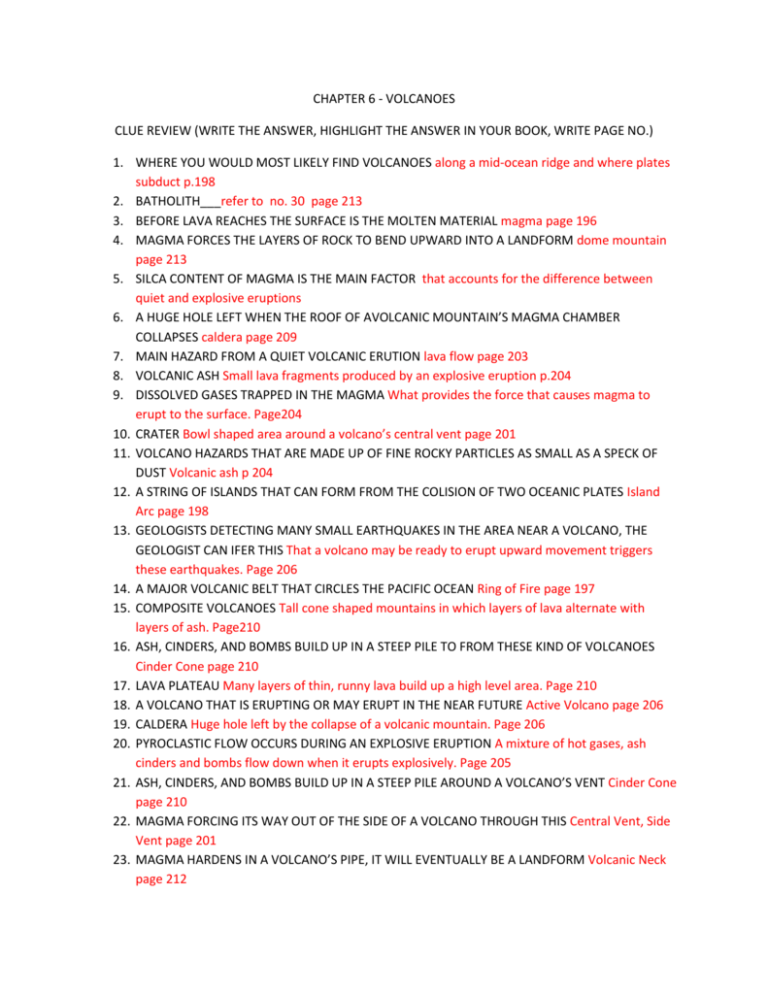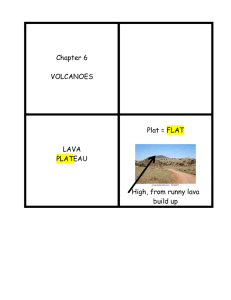CHAPTER-6-VOLCANOES-TAKEN-FROM-TEST
advertisement

CHAPTER 6 - VOLCANOES CLUE REVIEW (WRITE THE ANSWER, HIGHLIGHT THE ANSWER IN YOUR BOOK, WRITE PAGE NO.) 1. WHERE YOU WOULD MOST LIKELY FIND VOLCANOES along a mid-ocean ridge and where plates subduct p.198 2. BATHOLITH___refer to no. 30 page 213 3. BEFORE LAVA REACHES THE SURFACE IS THE MOLTEN MATERIAL magma page 196 4. MAGMA FORCES THE LAYERS OF ROCK TO BEND UPWARD INTO A LANDFORM dome mountain page 213 5. SILCA CONTENT OF MAGMA IS THE MAIN FACTOR that accounts for the difference between quiet and explosive eruptions 6. A HUGE HOLE LEFT WHEN THE ROOF OF AVOLCANIC MOUNTAIN’S MAGMA CHAMBER COLLAPSES caldera page 209 7. MAIN HAZARD FROM A QUIET VOLCANIC ERUTION lava flow page 203 8. VOLCANIC ASH Small lava fragments produced by an explosive eruption p.204 9. DISSOLVED GASES TRAPPED IN THE MAGMA What provides the force that causes magma to erupt to the surface. Page204 10. CRATER Bowl shaped area around a volcano’s central vent page 201 11. VOLCANO HAZARDS THAT ARE MADE UP OF FINE ROCKY PARTICLES AS SMALL AS A SPECK OF DUST Volcanic ash p 204 12. A STRING OF ISLANDS THAT CAN FORM FROM THE COLISION OF TWO OCEANIC PLATES Island Arc page 198 13. GEOLOGISTS DETECTING MANY SMALL EARTHQUAKES IN THE AREA NEAR A VOLCANO, THE GEOLOGIST CAN IFER THIS That a volcano may be ready to erupt upward movement triggers these earthquakes. Page 206 14. A MAJOR VOLCANIC BELT THAT CIRCLES THE PACIFIC OCEAN Ring of Fire page 197 15. COMPOSITE VOLCANOES Tall cone shaped mountains in which layers of lava alternate with layers of ash. Page210 16. ASH, CINDERS, AND BOMBS BUILD UP IN A STEEP PILE TO FROM THESE KIND OF VOLCANOES Cinder Cone page 210 17. LAVA PLATEAU Many layers of thin, runny lava build up a high level area. Page 210 18. A VOLCANO THAT IS ERUPTING OR MAY ERUPT IN THE NEAR FUTURE Active Volcano page 206 19. CALDERA Huge hole left by the collapse of a volcanic mountain. Page 206 20. PYROCLASTIC FLOW OCCURS DURING AN EXPLOSIVE ERUPTION A mixture of hot gases, ash cinders and bombs flow down when it erupts explosively. Page 205 21. ASH, CINDERS, AND BOMBS BUILD UP IN A STEEP PILE AROUND A VOLCANO’S VENT Cinder Cone page 210 22. MAGMA FORCING ITS WAY OUT OF THE SIDE OF A VOLCANO THROUGH THIS Central Vent, Side Vent page 201 23. MAGMA HARDENS IN A VOLCANO’S PIPE, IT WILL EVENTUALLY BE A LANDFORM Volcanic Neck page 212 24. VOLCANOES FORM ALONG A MID-OCEAN RIDGE WILL OCCUR AT THIS BOUNDARY Diverging plate boundaries page 198 Cinder Cones page 210 Volcanoes erupt explosively producing ash, cinders, and bombs. These materials can build up around the vent in steep cone-shaped hill or small mountain called a cinder cone. 25. ________________________________________ Composite Volcano page 210 Tall, cone shaped moutains in which layers of lava alternate with layers of ash. Quiet and explosive 26. _________________________________________ Shield Volcano page 210 Thin layers of lava pour out of a vent and harden on top of previous layers. Such lava flows slowly building a wide gentle slope mountain. Quiet 27. __________________________________________ Lava Plateau page 211 28. ______________________ Lava can flow out of several long cracks in an area. The thin, runy laa floods the area and travels far before cooling and becoming solid. Repeated floods of lava can form high plateaus. Caldera page 209 A hole left when a volcano collapses. A lake can form filling the hole. 29. _______________________ Batholith page 213 A mass of rock formed when a large body of magma cools inside the crust. Forms the core of many mountain ranges. 30. ______________________ Dike page 212 Magma that forces itself across rock layers. 31. _______________________ Sill page 212 Magma that squeezes between rock layers and hardens. 32. _______________________ Volcanic neck page 212 Magma hardens in a volcano’s pipe and the surround rock layer wears always. 33. __________________________






